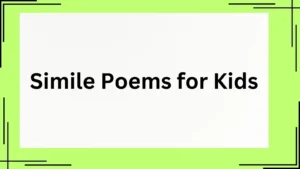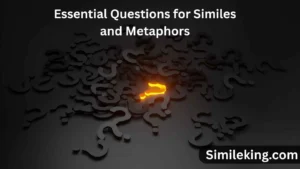Feeling worried is a natural human response to uncertainty or anxiety.
Whether you’re concerned about a personal situation or facing professional challenges, expressing your worry in a suitable manner is crucial.
In many conversations, we look for ways to describe this emotion using similes or alternative phrases that convey our feelings effectively, while considering the context and the tone of the conversation.
In this article, we’ll explore more than ten similes and alternatives to the word “worried” that can be used in different contexts.
We’ll also discuss when to use formal or casual expressions, how to best communicate concern in text messages, and much more.
This guide will help you articulate your thoughts clearly and appropriately.
1. Like a Cat on a Hot Tin Roof
This classic simile paints a vivid picture of a person who is extremely anxious or nervous, unable to stay still because of their heightened state of worry.
Example:
She was like a cat on a hot tin roof before the interview, pacing around and double-checking everything.
Context:
Use this simile when describing someone who’s restless or agitated due to anxiety. It’s informal and often best used in casual settings.
2. Like a Deer in Headlights
A common simile used to describe someone who is frozen in fear or overwhelmed with worry, unable to make a decision or take action.
Example:
He looked like a deer in headlights when the boss asked him to present the project unexpectedly.
Context:
This simile works well in informal conversations and adds a touch of humor. It’s a great way to describe someone caught off guard or paralyzed by worry.
3. Like a Storm Cloud
Describing worry as a storm cloud suggests an impending sense of dread or a feeling that something bad is about to happen. It’s often used to express a looming sense of concern.
Example:
She could feel the storm cloud of worry hanging over her, knowing that the deadline was fast approaching.
Context:
Use this simile when discussing general, anticipatory worry, especially in more formal conversations where you want to convey a subtle sense of looming anxiety.
4. Like a Rabbit in a Snare
This simile evokes the image of an animal caught in a trap, representing a person who feels trapped by their worries, unable to escape or find relief.
Example:
He felt like a rabbit in a snare, overwhelmed by the pressure of making the right decision.
Context:
This can be used in both casual and semi-formal contexts. It works well to describe someone feeling cornered or stuck due to their concerns.
5. Like a Balloon Ready to Burst
When someone is holding back their emotions, including worry, and it feels like they might burst at any moment, this simile is an apt choice.
Example:
She was like a balloon ready to burst, with all her worries about the upcoming exam building up inside her.
Context:
This simile is perfect for informal conversations, where you’re expressing how someone is about to break under the weight of their concerns.
6. Like a Jittery Squirrel
If someone is excessively anxious or worried, moving about nervously, this simile can be used to describe their behavior.
Example:
He was like a jittery squirrel before the presentation, double-checking his notes and fidgeting with his pen.
Context:
This is a light-hearted and informal simile, great for describing someone who’s visibly nervous and can’t seem to relax.
7. Like a Shaky Leaf in the Wind
This simile conveys the feeling of being fragile and vulnerable under stress or worry, much like a leaf trembling in the wind.
Example:
She felt like a shaky leaf in the wind during the meeting, unsure of how her ideas would be received.
Context:
Appropriate for both casual and slightly more formal situations, this simile highlights a sense of fragility or uncertainty due to worry.
8. Like a Tightrope Walker
A person walking a tightrope must maintain balance under immense pressure, and similarly, this simile illustrates the anxiety of maintaining control in a tense situation.
Example:
He felt like a tightrope walker, constantly balancing his fear of failure with the pressure to succeed.
Context:
This is a great choice for professional or semi-formal conversations, especially when discussing high-stakes situations where worry is part of the equation.
9. Like a Clock Ticking in the Background
This simile refers to the feeling of time slipping away, creating a sense of pressure and worry that heightens as the deadline approaches.
Example:
The clock ticking in the background made her feel like time was running out, and her worry grew with every second.
Context:
This simile is ideal for formal discussions or in situations where time-related pressure and anxiety are a key factor in the conversation.
10. Like a Ticking Time Bomb
This simile is often used to describe someone whose worry is building up, potentially leading to a breakdown or an explosive outburst.
Example:
He felt like a ticking time bomb, worried that he wouldn’t be able to meet the project deadline.
Context:
This is a powerful and slightly more dramatic simile, perfect for informal or dramatic discussions about extreme anxiety or pressure.
How to Choose the Right Simile for “Worried”
The simile you choose will depend largely on the context, the tone of your conversation, and how you wish to convey the level of worry or anxiety.
- For Casual Conversations: Use lighter, more visual similes like “like a cat on a hot tin roof” or “like a jittery squirrel” when you want to keep things friendly and approachable.
- For Formal Situations: Choose similes that are more restrained, such as “like a storm cloud” or “like a clock ticking in the background.” These express concern without sounding overly dramatic.
- For Expressing Extreme Worry: Consider similes like “like a ticking time bomb” or “like a balloon ready to burst” when you want to emphasize the intensity of someone’s anxiety.
8 Texting Examples for “Worried”
Here are eight texting examples designed to convey worry in a way that’s user-friendly and appropriate for different contexts:
- “I’m feeling like a cat on a hot tin roof about tomorrow’s meeting. I just can’t relax!”
(Casual tone, expressing restlessness.) - “I’m a bit like a deer in headlights right now. Not sure what to do next.”
(Casual, expressing confusion and being overwhelmed.) - “I’ve got a storm cloud hanging over me with all these deadlines. Hoping I can make it through!”
(Professional tone, describing looming pressure.) - “I feel like a rabbit in a snare, unable to make a decision. Can’t seem to get out of my head!”
(Informal, describing a trapped feeling.) - “I’m like a balloon ready to burst with everything going on. I just need a break.”
(Casual, expressing emotional overload.) - “I’ve been so jittery today, like a squirrel on too much caffeine!”
(Informal, describing nervous energy.) - “I feel like a shaky leaf in the wind with all the uncertainty around me.”
(Casual, expressing fragility.) - “I’m walking on a tightrope with all the work I have left to do. It’s hard to keep everything balanced.”
(Professional, discussing work-related anxiety.)
Conclusion
Worry is a universal emotion, and knowing how to express it effectively in different contexts can make all the difference in communication. Whether you’re having a casual chat or dealing with a formal business conversation, there are plenty of similes you can use to describe worry. From “like a cat on a hot tin roof” to “like a ticking time bomb,” these alternatives offer a range of tones and nuances to suit any situation. By selecting the right expression, you can convey your feelings more clearly and appropriately.





